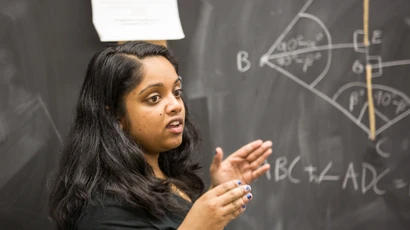
Courses: What should I take first?
Where should a student begin in Mathematical Sciences coursework?
For information on Advanced Standing Credit (e.g. AP Credit) and course transfer equivalencies, see here.
MATH 223 University Calculus III (No general education credit)
Placement: Student should have credit for MATH 122 and MATH 123, perhaps by scoring a 4 or 5 on the AP Calculus BC exam.
MATH 123 University Calculus II (No general education credit)
Placement: Student should have credit for MATH 122, perhaps by scoring a 4 or 5 on the AP Calculus AB exam.
MATH 122 University Calculus I (General Education – Mathematics/Quantitative Reasoning)
Placement: Student should have taken 4 years of college-preparatory mathematics in high school, including precalculus, with a B or better in the 4th-year course and an 85 or better on the Algebra II & Trigonometry Regents exam, or should have passed MATH 105 (or equivalent).
Intended audience for University Calculus: Students majoring in mathematics, chemistry, physics, or cooperative engineering. This is also an excellent course for students with good mathematics backgrounds and an aptitude for and an interest in mathematics. Credit will not be given for both MATH 120 and MATH 122.
MATH 121 Survey of Calculus II
Placement: Student should have credit for MATH 120, perhaps by scoring a 3, 4, or 5 on the AP Calculus AB exam.
MATH 120 Survey of Calculus I (General Education – Mathematics/Quantitative Reasoning)
Placement: Sudent should have taken 4 years of college-preparatory mathematics in high school, including precalculus, with an 80 or better on the Algebra II & Trigonometry Regents exam, or should have passed MATH 105 with a C+ or better.
Intended audience for Survey of Calculus: Students majoring in business administration, social science, biology, or computer science. The Survey of Calculus sequence covers much of the same material as University Calculus, but not in as much depth. Also, there is more emphasis on business applications. Good mathematics students should take University Calculus.
Credit will not be given for both MATH 120 and MATH 122.
MATH 110 Mathematics in Action (General Education – Mathematics/Quantitative Reasoning)
Placement: Student should have passed the NYS Algebra II & Trigonometry Regents.
Intended audience: This course was designed for general eucation and the elementary education mathematics concentration. It is an excellent course for those students who wish to explore some useful quantitative concepts and do not plan to take any additional mathematics. For majors in Early Childhood or Childhood Education, MATH 110 satisfies one of the requirements in the Mathematics Concentration. The course examines topics not generally covered in high school such as design of street networks, planning and scheduling, voting systems, and measuring populations.
MATH 108 Prize-Winning Mathematics (General Education – Mathematics/Quantitative Reasoning)
Placement: Student should have a 75 or better on the NYS Algebra II & Trigonometry Regents.
Intended audience: Students majoring in business administration, computer information systems or social science. Topics will be selected from systems of equations, matrix algebra, inequalities and linear programming, probability, games and decisions, and Markov chains. In 1976, George Dantzig was awarded the National Medal of Science, “For inventing linear programming and discovering methods that led to wide-scale scientific and technical applications.” In 1950, John Forbes Nash received his doctorate in mathematics from Princeton with a dissertation entitled, “Non-cooperative games.” Over forty years later, he received the Nobel Prize in Economics for this work. New England Patriot’s coach Bill Belichick, who studies game theory, read a paper showing that teams punt too often on fourth down. In the 2005 AFC championship game, the Patriots fooled the opposition by successfully running on fourth and one. They won the game, and went on to win their third Super Bowl title. This course will survey some of this prize-winning mathematics, with topics selected from linear models, matrices, linear programming, nonlinear and probabilistic models, and game theory.
STAT 150 Statistical Ideas (General Education – Mathematics/Quantitative Reasoning)
Placement: Student should have passed the NYS Algebra II & Trigonometry Regents.
Intended audience: The purpose of this course is to introduce students to the field of statistics, to examine the role that it plays in our lives, and to help students avoid being hoodwinked by the misuse of statistics. This course was designed for the general education program. The emphasis will be on data and concepts rather than on calculations and mathematical theory.
STAT 200 Statistical Methods (General Education – Mathematics/Quantitative Reasoning)
Placement: Student should have passed the NYS Algebra II & Trigonometry Regents.
Intended audience: This course is designed to introduce students to the use of statistical techniques in business, economics, education, and the social sciences.
STAT 250 Statistics for Scientists (General Education – Mathematics/Quantitative Reasoning)
Placement: Student should have passed the NYS Algebra II & Trigonometry Regents.
Intended audience: This course is designed to introduce students to the use of statistical techniques in the sciences.
MATH 105 – Survey of Precalculus (No general education credit)
Placement: Student should have passed the Geometry Regents exam, or equivalent.
Intended audience: Students who plan to take MATH 120 Survey of Calculus I or MATH 122 University Calculus I, but need additional preparation; in particular, for those who took the Algebra II & Trigonometry Regents exam but scored less than 75. This course will review algebra and geometry, and cover algebraic, exponential, logarithmic, and trigonometric functions, transformations and combinations of functions, solving inequalities, systems of equations and graphing calculators.
